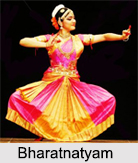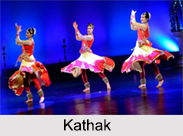 Classical dances of India are one of the most comprehensive and oldest dance forms in the world. India offers a number of classical dance forms, each of which can be traced to different parts of the country. Each of these dance form represents the culture of a particular region or group of people. India is a land of multiple languages, culture and traditions. These classical dances of India have definite rules that have been followed traditionally over the years. Dance is a physical as well as virtual form of art. Natya Shastra, which is regarded as the fifth Veda, is considered to be the source of all classical dance forms in India. It is believed to have been written between 2nd century BC and 2nd century A.D.
Classical dances of India are one of the most comprehensive and oldest dance forms in the world. India offers a number of classical dance forms, each of which can be traced to different parts of the country. Each of these dance form represents the culture of a particular region or group of people. India is a land of multiple languages, culture and traditions. These classical dances of India have definite rules that have been followed traditionally over the years. Dance is a physical as well as virtual form of art. Natya Shastra, which is regarded as the fifth Veda, is considered to be the source of all classical dance forms in India. It is believed to have been written between 2nd century BC and 2nd century A.D.The classical dances of India mainly focus on the Navarasas or emotions - Hasya Rasa, Raudra Rasa, Bibhatsa Rasa, Bhayanaka Rasa, Vira Rasa, Sringara Rasa, Karuna Rasa, Adbhuta Rasa and Shanta Rasa. Almost all the classical dance forms follow the same hand gestures. There are various names by which the dance forms are known. There are 8 classical dances of India that has got recognition from the Sangeet Natak Academy of India. And these classical dances of India are: Bharatnatyam, Kathak, Kathakali, Kuchipudi, Manipuri, Mohiniattam, Odissi and Sattriya. There are shlokas in Natya Shastra that describe how to perform all the movements in Indian classical dances.
Types of Classical Dances of India
Traditionally performed as an expressive dance-drama form of religious performance art, the classical dances of India relates to Vaishnavism, Shaivism, Shaktism along with pan-Hindu epics. It also relates to Vedic literature, or a folksy entertainment that includes story-telling from Sanskrit or regional language plays. The Natya Shastra, which is the foundational treatise for classical dances of India mentions 4 genres of ancient dance-drama in vogue when it was composed – Avanti, Dakshinatya, Panchali and Odra-Magadhi. Discussed elaborately below are the 8 classical dances of India.
 Bharatnatyam: Considered to be a ‘fire dance’, the classical dance form of Bharatnatyam includes the element of air, water, earth and sky. The movements of a Bharatnatyam dancer reflect the mysterious display of the abstract element of fire. It is a solo, feminine type of a dance, which is tender and erotic. The basic theme is love, where the female dancers usually perform as a devotion to the Supreme Being; or love of a mother for child. It epitomizes the adoration of lovers separated and reunited. Bharatnatyam is one of the popular classical dances of India that originated in the southern state of Tamil Nadu. It is unique to the Dravidian culture of South India. In the ancient days, devdasis or temple dancers who were dedicated in service to the presiding deities used to perform Bharatanatyam in temples. It was E. Krishna Iyer was the one who raised the status of Bhartanatyam and popularized it. Rukmini Devi Arundale was influential in bringing it to the attention of the West. There are several religious mythologies associated with the origin of this dance form. It got its name from sage Bharata who was entrusted with the work of writing Natya Shastra following the instructions of Lord Brahma.
Bharatnatyam: Considered to be a ‘fire dance’, the classical dance form of Bharatnatyam includes the element of air, water, earth and sky. The movements of a Bharatnatyam dancer reflect the mysterious display of the abstract element of fire. It is a solo, feminine type of a dance, which is tender and erotic. The basic theme is love, where the female dancers usually perform as a devotion to the Supreme Being; or love of a mother for child. It epitomizes the adoration of lovers separated and reunited. Bharatnatyam is one of the popular classical dances of India that originated in the southern state of Tamil Nadu. It is unique to the Dravidian culture of South India. In the ancient days, devdasis or temple dancers who were dedicated in service to the presiding deities used to perform Bharatanatyam in temples. It was E. Krishna Iyer was the one who raised the status of Bhartanatyam and popularized it. Rukmini Devi Arundale was influential in bringing it to the attention of the West. There are several religious mythologies associated with the origin of this dance form. It got its name from sage Bharata who was entrusted with the work of writing Natya Shastra following the instructions of Lord Brahma.Kathak: A dance of northern India, Kathak is often a dance of love. From 16th century onwards it absorbed certain features of Persian dance and Central Asian dance which were imported by the Mughal era. There are 3 major gharanas of Kathak from which performers today draw their lineage: the gharanas of Jaipur, Lucknow and Varanasi along with the less prominent Raigarh gharana. It is performed by both men and women. The movements include intricate footwork accented by bells worn around the ankles and stylized gestures adapted from normal body language. It was originated by Kathakas, professional storytellers who used a mixture of dance, song and drama. Like other Indian dances it began as a temple dance, but soon moved into the courts of ruling houses.
For an informative read on differrent forms of Indian classical dance, their origin and evolution, check the link